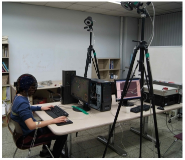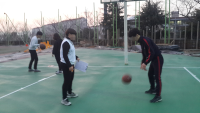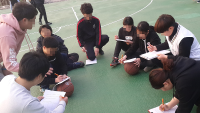
The purpose of this study was to determine how acute active pc-video game affects kinematic variables and muscle activities of adolescents. Fourteen middle school students(age: 15.9±0.7 yrs, height: 171.3±6.1cm, weight: 60.0±5.4 kg, right handed) who have no musculoskeletal disorder were recruited as the subject according to having experience in using the pc-video game for more than six months. Maximum angle, angular velocity, and muscle activity of the upper extremity were determined for each trial. For each dependent variable, a paired t-test was performed to test if significant difference existed between pre- and post a 60 minute active pc-video game(p<.05). This study found that one hour pc-video game hour may not affect on movement and ROM of the finger and the wrist, whereas it may have an effect on muscle activity of the upper extremity. It seems that repetitive movement pattern during an active pc-video game may hinder muscle activity of adolescents’ upper extremity. Part of the increase in musculoskeletal disorders is linked to the amount of time adolescents are allowed to play video games. This study found that an active pc-video game appears to have negative effects on the upper extremity muscles. Since wrist movements are continually repeated throughout the video game, carpal tunnel syndrome may possibly be caused by long-term exposure to video games.


The purpose of the study was to determine relationship of abdominal fat, adipocytokine, bone mineral density, and bone turnover markers in obese male adolescents. Twenty four male adolescents (obese: 12, normal: 12) volunteered to participate in the study. Anthropometry and skeletal maturity were measured. Body composition and bone mineral density were estimated by DXA (Hologic, QDR-4500, USA). Abdominal fat with total adipose tissue (TAT), visceral adipose tissue (VAT), subcutaneous adipose tissue (SAT), and visceral adipose tissue to subcutaneous adipose tissue ratio (VSR) were estimated by computed tomography (ECLOS, HITACH, Japan). Blood samples were obtained for and analysis of adipocytokines including leptin and adiponectin. Bone turnover markers, osteocalcin (OC), bone-specific alkaline phosphatase (BALP) for bone formation markers and N-terminal telopeptide (NTx), C-terminal telopeptide (CTx) for bone resorption markers were analysed. All data were analyzed utilizing SAS 9.3 (SAS Institute, NC, USA). Independent t-test was used to evaluate the differences between obese adolescents and normal adolescents. Pearson correlation analysis was applied to figure out the relationship between abdominal fat, adipocytokines, bone mineral density, and bone turnover markers. Multiple regression analysis was used to find out the factors of abdominal fat which influence on bone mineral density. A level of significance was set at p<.05. The results of the study indicated that fat tissue (p<.001), percent body fat (p<0.001), TAT (p<.001), VAT (p<.001), and SAT (p<0.001) were significantly higher in obese adolescents than normal adolescents. However bone mineral contents were significantly higher in normal adolescents. Normal adolescents have significantly higher whole body BMD and lumber BMD than obese adolescents. Abdominal fat including VAT and SAT related negatively with whole body BMD and lumbar BMD. Leptin related negatively with BMD whereas adiponectin related positively with BMD. NTx for bone resorption marker related positively with abdominal fat. Visceral adipose tissue was a predictor for whole body BMD and lumbar BMD in explaining 46% and 32% in adolescents. In conclusion, obese male adolescents have lower whole body BMD and lumbar BMD than normal adolescents. Abdominal fat including VAT and SAT related negatively with whole body BMD and Lumbar BMD. And leptin and adiponectin were closely related with BMD. Finally, visceral adipose tissue was a predictor for whole body and lumbar BMD in adolescents.
PURPOSE Through analysis, this study reports on occurrences of children and adolescents’ sports accidents and presents measures to prevent, cope with, and manage school sports accidents. METHODS The study used both quantitative and qualitative methods. First, a frequency analysis was conducted using 284,429 safety accident data of the School Safety and Insurance Association (SSIA). Second, the inductive analysis method was applied to in-depth interviews conducted with eight teachers. RESULTS , accidents are characterized as follows: 1) At the school level, accidents have increased significantly every year in a large proportion of elementary and middle schools. 2) The span of time spent on sports was large. 3) Accidents happened at playgrounds and auxiliary facilities. 4) Accidents happened during kindergarten play and ball sports in schools. 5) The descending order of days with the most accidents was Thursday, Tuesday, Friday, Wednesday, Monday, Saturday, and Sunday. 6) Rather than a certain month, accidents happened across the school semester. 7) Most accidents occurred from 10 a.m. to 2 p.m. Second, field teachers’ stories were categorized into the following topics. 1) School accidents can occur anytime, anywhere. Whether mild or serious, they still had the burden of inevitable accidents. 2) Required: were prompt response and handling by appropriate teachers; timely treatment and recovery cost support; also procedurally simplified handling by SSIA was helpful. 3) Avoiding accidents requires the following:: regular operation of safety education programs; daily promotion of teachers’ preventive observation and close guidance; and active role reinforcement of SSIA and policy support. CONCLUSIONS Finally, measures to prevent, cope with, and manage school safety accidents were proposed.

Purpose The purpose of this study was to further understand how out-of-school adolescents’ self-esteem and interpersonal relations have changed in a peer mentoring basketball program and what they have experienced for the program It was action research of qualitative research method. Methods 4 out-of-school adolescents in the adolescents Center of C-si were selected as the participant. The data was collected by in-depth interviews, participant observation, and research journal. The collected data was then analyzed by an inductive categorical system. Results The findings were summarized as follows: the out-of-school adolescents showed somewhat low self-esteem and difficulties of interpersonal relations at an early stage participating in the peer mentoring basketball program. However, their self-esteem and interpersonal relations have been gradually changed during the program. First, they participated in various mentoring activities and self-expression activities. Their self-esteem has been improved as they found their real values, communicated with others, and lived with their confidence. Second, they overcame personal relations with fear and indifference of others, extended personal relations, and sympathized with others to solve the problem that they had as interpersonal relations. Conclusions The out-of-school adolescents has positively changed their self-esteem and interpersonal relations through the peer mentoring basketball program. We expect that out-of-school adolescents could overcome their difficulty and live well their life in the future.


PURPOSE This study aimed to verify the relationship between adolescent athletes’ julsil, competitive trait anxiety, and self-management. METHODS A total of 370 adolescent athletes who were registered with the Korean Sport & Olympic Committee participated in the survey; 24 insincere responses were excluded from the analysis, leaving a total of 346 participants. After verifying the construct validity of the measurement tool used in the survey, statistical and correlation analyses were performed. The research model was subsequently verified using structural equation modeling. RESULTS Adolescent athletes’ julsil had a significant positive effect on self-management but not on competitive trait anxiety. In addition, self-management was found to have a significant negative effect on competitive trait anxiety, and also completely mediated the relationship between julsil and competitive trait anxiety. CONCLUSIONS Adolescent athletes’ julsil does not increase competitive trait anxiety, but rather plays a role in reducing it by increasing self-management. These findings unveil mechanisms through which julsil can be used to enhance athlete performance.
PURPOSE This study examined Julsil impact on self-management and the moderating effect of achievement goal orientation in adolescent male athletes. METHODS Adolescent male athletes (n=248) registered with the Korean Sports & Olympic Committee participated in a survey. After exclusion of data from seven respondents who provided insincere responses, 241 responses were used for the final analysis. After verification of the measurement tool’s construct validity, technical statistical analysis and correlation analysis were performed. Finally, multiple regression analysis and PROCESS Macro (Model 1) were used to verify the research hypothesis. RESULTS 1) Male adolescent athletes’ Julsil and 2) task goal orientation had significant positive effects on self-management,, but ego goal orientation did not. 3) The moderating effect of task goal orientation on the relationship between Julsil and self-management was significant, but that of ego goal orientation was not. CONCLUSIONS 1) Male adolescent athletes’ Julsil and 2) task goal orientation had significant positive effects on self-management,, but ego goal orientation did not. 3) The moderating effect of task goal orientation on the relationship between Julsil and self-management was significant, but that of ego goal orientation was not.
PURPOSE This study aimed to examine the effects of motion analysis and image training using self-modeling with visual cues on the skill performance, imagery, and sports confidence of adolescent female soccer players. METHODS The participants were elite soccer players from two girls’ high school soccer teams divided into an experimental group (D girls’ high school, n=16) and a control group (I girls’ high school, n=13). The experimental group underwent motion analysis and image training when performing penalty kicks, short kicks, and long kicks using self-modeling with visual cues, while the control group underwent training using self-modeling videos without visual cues. Before and after the training, the evaluation score was calculated according to kick performance, and the imagery and sports confidence factors were measured. For the statistical analysis of all collected data, descriptive statistics, the Friedman test, the Mann-Whitney U test, and two-way repeated-measures analysis of variance were used. RESULTS First, on the motion analysis using self-modeling with visual cues, the experimental group’s penalty kick and short kick scores were improved and differed significantly, but no significant change was noted in long kick score. Second, as a result of image training using self-modeling with visual cues, all visual, kinesthetic, mood, and controllability factors of the experimental group improved except for the auditory factor, and the interaction effect was confirmed. In addition, the stated sports confidence of the experimental group was improved and the interaction effect confirmed. CONCLUSIONS The analysis of kick motion using self-modeling with visual cues was effective for the penalty kicks and short kicks of adolescent female soccer players. Moreover, this study confirmed that the analysis of kick motion improved the visual, kinesthetic, mood, and controllability sub-factors of imagery and significantly affected the players’ stated sports confidence.
PURPOSE This study aimed to identify movement pattern differences in the running of youth soccer players with and without lateral ankle sprain (LAS) histories. METHODS A total of 12 participants were recruited and assigned to the LAS group or the control group. All participants were assessed for anthropometric data, and they filled in the subjective ankle function questionnaires. Then, reflective markers were attached to their bodies, and they were instructed to run at the preferred speed on the 9-m runway thrice. 3D joint angles for ankle, knee, and hip joints were exported, and their mean values and 95% confidence intervals were calculated. Ensemble curve analysis was conducted to compare running kinematics between the groups. RESULTS The LAS group exhibited fewer dorsiflexion angles and more inversion angles compared to the control group. Excluding the dorsiflexion deficits and more inverted ankles, there were no significant differences between the groups. CONCLUSIONS Although the ankle kinematic patterns found in this paper are not considered LAS risk factors, it will be able to identify precise LAS risk factors with prospective design (e.g., lower extremity movement patterns) as well as intrinsic risk factors.
The purpose of this study was to examine the relationship of obesity index, fitness and cardiovascular risk index in middle and high school students. Obesity index, fitness score and cardiovascular risk index were measured from 1,044 middle and high school students. The results of relation between obesity index and fitness showed that the higher obesity index had significantly lower fitness score for both boys and girls (boys: p<0.001, girl: p<0.05) The results of relation between obesity index and cardiovascular risk index indicated that the higher obesity index had significantly higher cardiovascular risk index for both boys and girls (boys: p<0.001, girl: p<0.001). Moreover, The lower fitness index showed significantly higher cardiovascular risk index regardless of gender in middle school students (boys: p<0.001, girl: p<0.01). Therefore, the results of this study indicated that obese adolescents had the lower fitness level and high possibility of cardiovascular risk.

Purpose The purpose of this study was to develop a comprehensive model for facilitating and hindering factors about girls' participation in physical activities. Methods Based on systematic analysis, 26 foreign journals published from 2005 to 2016 were comprehensively analyzed. The journals were directed to facilitating and hindering factors of girls' physical activities. A model was developed by categorizing various factors in the previous studies, and by conceptualizing those categories, and by creating visualization of relations between the categories. Results Seven facilitating factors are referred to as 'SPORTS', including ‘Self-recognition’, ‘Physical environment’, ‘Opportunities’, ‘Relationship’, ‘Treatment’, and ‘Social supports’. In contrast, nine hindering factors are conceptualized as 'INCAPABLE' which includes 'Internalized gazes’, ‘Negative feedback’, ‘Competitiveness’, ‘Alternativeness’, ‘Perceived danger’, ‘Appearance’, ‘Bad feeling’, ‘Lack of opportunities’, and ‘Effeminate norms'. Conclusions It is suggested that the girls' physical activity patterns vary depending on whether the girls subjectively interpret the physical activity or girls are being objectified by other's evaluation. And those individual, relational, and environmental levels are needed to strengthen the subjectification of girls.

